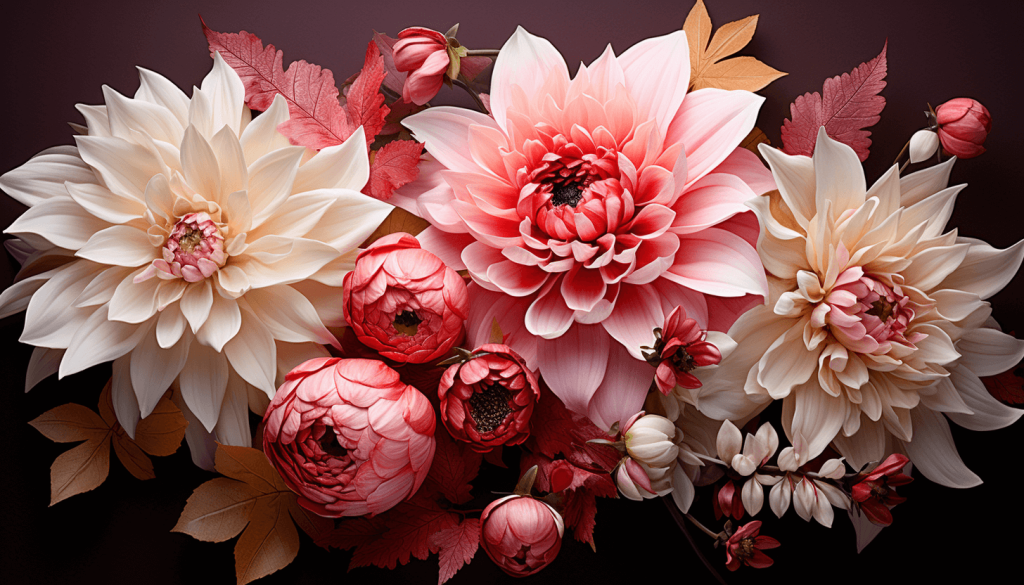As the vibrant hues of autumn paint the landscape, November introduces us to two of its most cherished blooms: the Chrysanthemum and the Peony. The Chrysanthemum, with its myriad of petals, stands as a symbol of joy, longevity, and rejuvenation. It’s a flower that has been celebrated for centuries, especially in Asian cultures, for its radiant beauty and profound meanings. On the other hand, the Peony, often regarded as the “queen of flowers,” embodies romance, prosperity, and honor. Its lush, rounded blooms are a sight to behold, making it a favorite in many gardens and floral arrangements.
If you’re fascinated by the intricate tales and meanings behind birth flowers, you might find our comprehensive guide enlightening. And for those with an interest in the shimmering world of gems, our exploration into the monthly birthstones is a must-read, offering insights into each month’s representative gem.
Symbolism of the Chrysanthemum: Delving into the Meanings of November’s Radiant Bloom
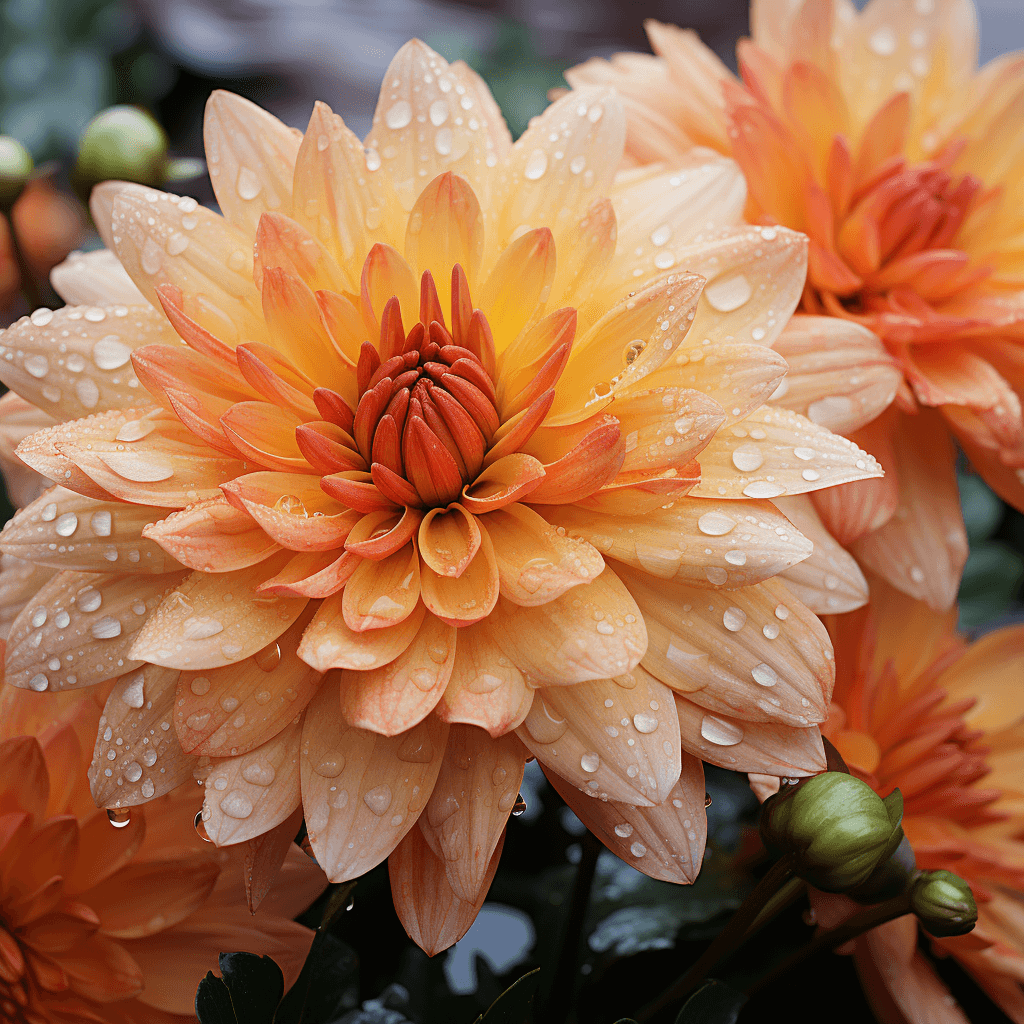
The Chrysanthemum, often simply referred to as the ‘mum’, is a flower steeped in rich symbolism and history. Its name originates from the Greek words ‘chrysos’ meaning gold and ‘anthemon’ meaning flower, which is fitting given its golden-hued varieties and its golden status in many cultures.
One of the primary meanings associated with the Chrysanthemum is longevity. In many Asian cultures, particularly in China and Japan, the flower is a symbol of a long and happy life. It’s not uncommon for people to drink Chrysanthemum tea or use the flower in various ceremonies to promote good health and longevity.
Another significant symbolism attached to the Chrysanthemum is rebirth and renewal. As it blooms in the fall, it serves as a reminder that even as the year winds down, life and beauty persist. This idea of rebirth is further emphasized by the flower’s tight-packed petals, which unfold in layers, symbolizing the many layers and chapters of life.
Furthermore, the Chrysanthemum is also a symbol of joy and happiness. Its bright colors and intricate patterns bring cheer to any setting, making it a popular choice for celebrations and happy occasions. In some cultures, it’s even believed that bringing a single Chrysanthemum into your home can lift spirits and bring about laughter.
In conclusion, the Chrysanthemum, with its deep-rooted symbolism, is not just a flower to admire for its beauty but also to cherish for the profound meanings it carries.
Historical Significance of the Chrysanthemum: From Ancient China to Modern Bouquets
The Chrysanthemum boasts a history that spans millennia, with its origins tracing back to ancient China. Revered for both its beauty and its medicinal properties, this flower has played a pivotal role in various cultures and epochs.
In ancient China, the Chrysanthemum was first cultivated as a flowering herb as far back as the 15th century BC. It was not just admired for its aesthetic appeal but was also an integral part of traditional Chinese medicine. The flower, particularly its petals and roots, were often used to brew teas that were believed to have cooling properties, beneficial for fever and inflammation.
“The Chrysanthemum, known as ‘Ju’ in ancient texts, was associated with tranquility and the simplicity of the rural life.”
Moving from China to Japan, the Chrysanthemum found equal adoration. By the 8th century AD, it had become so beloved that it was adopted as the imperial seal. The annual Chrysanthemum Festival, or ‘Kiku Matsuri’, celebrates the flower’s significance and is still observed today, with intricate displays of the flower showcasing Japanese horticultural prowess.
Europe was introduced to the Chrysanthemum in the 17th century. Its popularity surged, especially in France, leading to extensive cultivation and breeding, resulting in the many varied forms and colors we see today.
In modern times, the Chrysanthemum continues to be a favorite in gardens and bouquets worldwide, symbolizing joy, longevity, and renewal. Its rich history and cultural significance add depth to its vibrant petals, making it a flower that tells tales as old as time.
Astrological Insights on the Chrysanthemum: How the Chrysanthemum Resonates with Scorpio and Sagittarius Energies
November, a month of transformation and introspection, is governed by the zodiac signs of Scorpio and Sagittarius. As the days grow shorter and the nights longer, the Chrysanthemum emerges as a beacon of light, mirroring the profound depths and expansive visions of these two signs. Let’s delve into the cosmic resonance of the Chrysanthemum with these zodiac energies.
Scorpio: The Depths of Passion and Transformation
Scorpio, ruled by the mysterious Pluto, is a sign of depth, intensity, and transformation. Just as the Chrysanthemum blooms in the heart of autumn, Scorpios thrive in moments of profound change and rebirth. The flower’s radiant petals reflect Scorpio’s passion and determination, while its core symbolizes the depth of their emotions and intuition.
“In the silent whispers of the Chrysanthemum, Scorpios might find echoes of their own transformative journeys, from the shadows to the light.”
Sagittarius: The Quest for Knowledge and Adventure
As November transitions into its latter half, the sun enters the realm of Sagittarius, the archer. Ruled by expansive Jupiter, Sagittarians are known for their love of adventure, knowledge, and freedom. The Chrysanthemum, with its wide-open petals, mirrors the Sagittarian spirit of openness and exploration. Its diverse hues and varieties can be likened to the many paths a Sagittarius might take in their quest for wisdom.
- Fiery Reds and Oranges: Representing the Sagittarian zest for life and their fiery enthusiasm.
- Soft Pinks and Whites: Symbolizing their gentle optimism and hope for the future.
- Deep Purples: Reflecting their philosophical inclinations and the depth of their inquiries.
In the dance of the stars, the Chrysanthemum finds its rhythm, resonating deeply with the transformative energies of Scorpio and the expansive visions of Sagittarius. As November’s birth flower, it serves as a reminder of the depth and breadth of human experience, beautifully encapsulated in its petals.
Chrysanthemum Colors & Their Meanings: Decoding the Spectrum of Emotions Represented by the Chrysanthemum
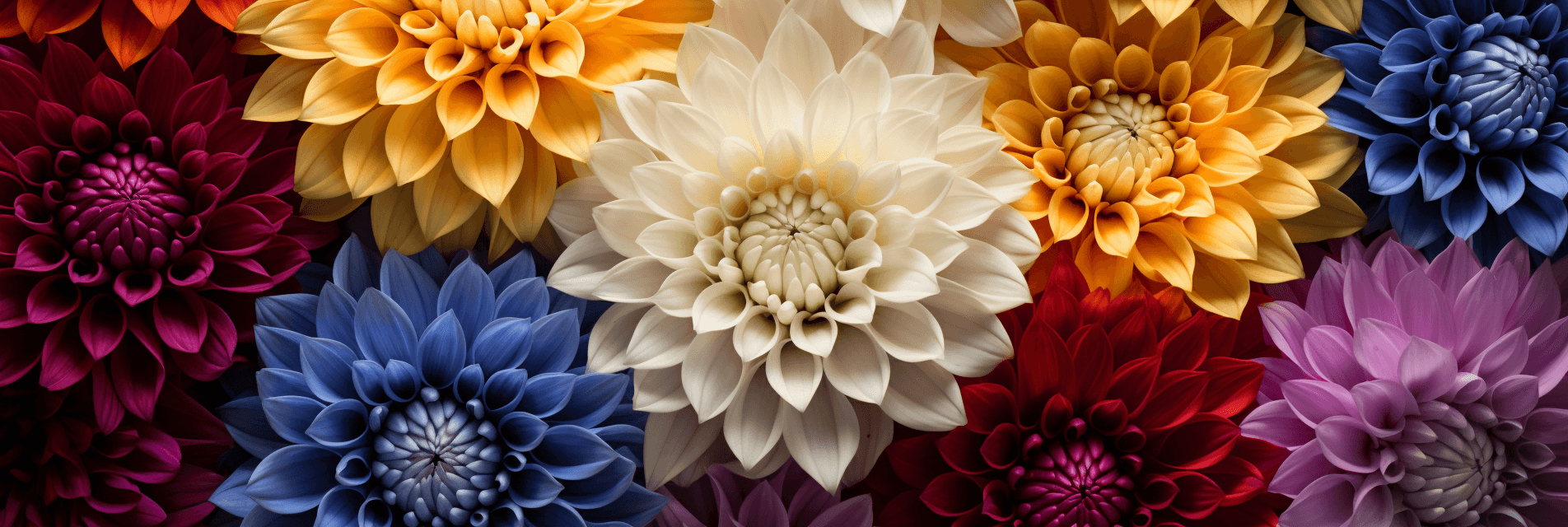
With its myriad of colors and intricate petal designs, the Chrysanthemum is not just a feast for the eyes but also a symbol of various emotions and sentiments. Each hue of this magnificent flower carries a unique message, deeply rooted in cultural and historical contexts. Let’s embark on a colorful journey to understand the emotions and meanings associated with different Chrysanthemum colors.
| Color | Meaning |
|---|---|
| Red | Symbolizing love and deep passion, red Chrysanthemums are often gifted to express romantic feelings and admiration. |
| White | Representing purity, loyalty, and truth, white Chrysanthemums are a testament to genuine feelings and are often used in memorial services. |
| Yellow | Yellow Chrysanthemums, with their sunny disposition, signify neglected love or sorrow. They are also associated with slighted love in some cultures. |
| Purple | Evoking feelings of royalty and nobility, purple Chrysanthemums stand for wishes of good health and longevity. |
| Pink | Symbolizing a budding romance, joy, and youthfulness, pink Chrysanthemums are often given in the early stages of a relationship. |
It’s fascinating how the same flower, in different shades, can convey such a wide range of emotions. Whether it’s the deep passion of red, the innocent purity of white, or the youthful exuberance of pink, the Chrysanthemum tells a story with every hue. So, the next time you’re looking to express your feelings with flowers, remember the rich tapestry of meanings woven into the Chrysanthemum’s vibrant colors.
“In the language of flowers, the Chrysanthemum speaks volumes, with each color narrating a unique tale of emotion and sentiment.”
Mythology and Folklore Surrounding the Chrysanthemum: Tales of Longevity, Vitality, and Passion
The Chrysanthemum, with its radiant petals and captivating aura, has been the muse of countless legends, myths, and folklore throughout history. From tales of undying love to symbols of life’s vitality, the Chrysanthemum has woven its way into the cultural fabric of many civilizations. Let’s journey through time and explore some of the most enchanting stories associated with this mesmerizing bloom.
The Immortal Chrysanthemum of China
In ancient China, the Chrysanthemum was revered as a symbol of longevity and vitality. Legend has it that consuming the dew from the petals of the Chrysanthemum could grant immortality. One such tale speaks of the great Taoist philosopher, Peng Zu, who, with a diet rich in Chrysanthemum wine, lived for 800 years!
Japan’s Festival of Happiness
The Chrysanthemum, or ‘Kiku’ in Japanese, holds a special place in Japan’s cultural heritage. Every year, the country celebrates the Chrysanthemum Festival, where the flower is honored for its symbolization of happiness and rejuvenation. The festival is rooted in a myth where the sun goddess Amaterasu, to bring back light to the world, was presented with a Chrysanthemum.
The Lover’s Chrysanthemum of Greece
In Greek mythology, the Chrysanthemum has a more romantic origin. It is said that the flower sprouted from the tears of the goddess Artemis over the loss of her beloved. Thus, in ancient Greece, the Chrysanthemum became a symbol of deep passion and undying love.
The Protective Powers in Victorian England
In Victorian England, the Chrysanthemum took on a protective role. Folklore suggests that placing Chrysanthemums by your doorstep would ward off evil spirits. They were also believed to protect one from curses and ill intentions.
From tales of undying love in Greece to symbols of protection in Victorian England, the Chrysanthemum’s rich tapestry of myths and legends spans across cultures and eras. These stories not only highlight the flower’s cultural significance but also its timeless appeal that continues to enchant hearts worldwide.
“The Chrysanthemum, with its tales as vibrant as its petals, remains an eternal symbol of life, love, and lore.”
The Chrysanthemum in Different Cultures: A Global Glimpse into the Celebrations and Uses of the Chrysanthemum
The Chrysanthemum, with its myriad of colors and forms, has captivated cultures worldwide. Its significance varies, but its beauty remains universally acknowledged. Let’s embark on a journey across continents, exploring the unique place the Chrysanthemum holds in various societies.
Japan: The Imperial Emblem
In Japan, the Chrysanthemum, known as ‘Kiku’, is deeply entrenched in the nation’s identity. It serves as the Imperial emblem and symbolizes longevity and rejuvenation. The annual Chrysanthemum Festival, or ‘Kiku no Sekku’, is a testament to its importance, where intricate displays of the flower are showcased, and various cultural performances take place.
China: The Flower of Autumn
For the Chinese, the Chrysanthemum is synonymous with autumn. It’s celebrated during the Double Ninth Festival, where drinking Chrysanthemum tea and hiking mountains are traditional activities. The flower symbolizes longevity and is believed to ward off evil spirits and misfortune.
Europe: The Flower of Remembrance
In several European countries, the Chrysanthemum is a symbol of death and is used to honor the departed. In nations like France and Belgium, it’s customary to place Chrysanthemums on graves during All Saints’ Day, paying respect to the deceased.
America: A Symbol of Cheerfulness
In the United States, the Chrysanthemum is often associated with cheerfulness and positivity. It’s a popular choice for fall decorations, given its vibrant colors that mirror the autumn foliage. The flower also plays a significant role in Mother’s Day celebrations, symbolizing love and support.
Australia: The Mother’s Day Flower
Down under, the Chrysanthemum is affectionately known as the ‘Mum’ and is the official flower of Mother’s Day. Its popularity stems from its seasonal availability and the phonetic similarity to the word ‘mum’, making it the perfect gift to honor mothers.
From being an emblem of royalty in Japan to a symbol of remembrance in Europe, the Chrysanthemum’s global journey is a testament to its versatility and enduring charm. Each culture, while interpreting the flower differently, unites in celebrating its undeniable beauty.
“Across borders and beliefs, the Chrysanthemum blooms as a beacon of tradition, respect, and admiration.”
Symbolism of the Peony: Embracing the Essence of Beauty, Honor, and Wealth
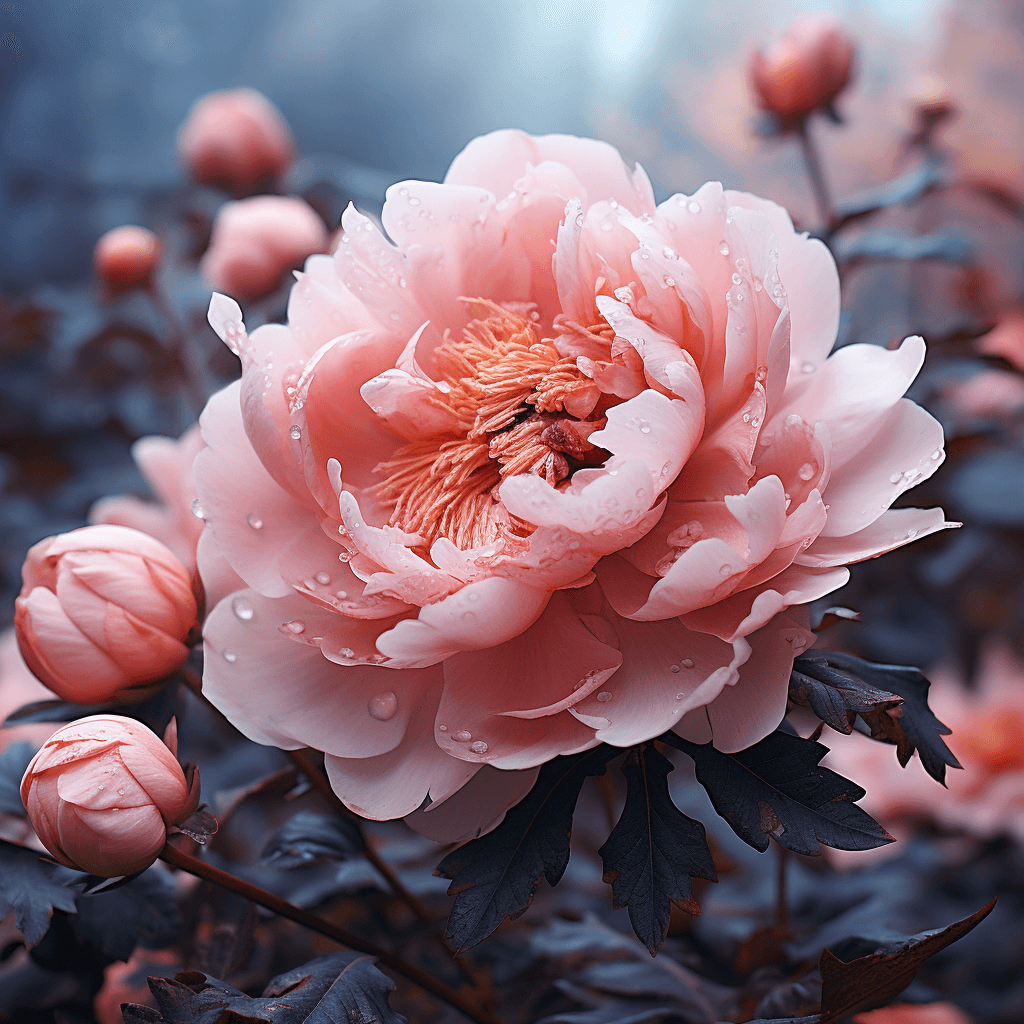
The Peony, with its lush, full blooms and intoxicating aroma, has long been revered in various cultures for its symbolic meanings. Often associated with opulence, honor, and romance, the Peony stands as a testament to nature’s ability to craft unparalleled beauty. Let’s delve deeper into the rich tapestry of symbolism that surrounds this magnificent flower.
Beauty in Full Bloom
Peonies, often termed the ‘Queen of Flowers’, are synonymous with beauty. Their large, ruffled petals, which can be found in a spectrum of colors, represent the epitome of beauty in the floral world. This association is particularly strong in Asian cultures, where art and poetry frequently celebrate the Peony’s aesthetic appeal.
Honor and Nobility
The Peony’s association with honor is deeply rooted in its history. In ancient times, only the nobility had the privilege of cultivating Peonies in their gardens. This flower, with its regal presence, became a symbol of high status and was often gifted as a sign of respect or admiration.
Wealth and Prosperity
With their full-bodied blooms, Peonies have come to symbolize abundance and wealth. In many cultures, particularly in China, they are considered good luck charms for financial prosperity. Businesses often display Peony paintings or plants, believing they will usher in economic success.
Romance and Compassion
Peonies are also emblematic of romance and compassionate love. Their soft, velvety petals and enchanting fragrance make them a popular choice for romantic occasions. In Western cultures, Peonies are a favorite for weddings, symbolizing a happy marriage, romance, and compassion.
Whether it’s their undeniable beauty, their association with nobility, or their symbolism of wealth and prosperity, Peonies have captured the hearts and imaginations of people for centuries. Their presence, whether in a garden or a bouquet, brings with it a sense of luxury, honor, and timeless beauty.
“The Peony, in all its radiant splendor, remains a symbol of life’s most beautiful and cherished moments.”
Historical Significance of the Peony: Tracing its Roots in Asian Cultures and Beyond
The Peony, a flower steeped in legend and history, has been celebrated for centuries across various cultures. Its journey from the gardens of ancient China to the bouquets of modern-day florists is a tale of admiration, art, and cultural exchange. Let’s embark on a historical exploration of the Peony’s rich past.
Origins in Ancient China
The Peony’s story begins in ancient China, where it was first cultivated over a thousand years ago. Revered as the ‘King of Flowers’, the Peony held a special place in the hearts of Chinese emperors and nobility. It was believed to bring good fortune, and its blossoms adorned the imperial palaces and gardens. The city of Luoyang, known as the ‘City of Peonies’, even hosts an annual festival celebrating this magnificent bloom.
Artistic Representations
Chinese art and literature are replete with references to the Peony. From intricate paintings to evocative poetry, the flower has been a muse for countless artists and poets. Its representation in art symbolized beauty, prosperity, and often, the romantic tales of lovers.
Introduction to Japan
The Peony’s allure wasn’t limited to China. By the 8th century, it made its way to Japan, where it was embraced with equal fervor. The Japanese cultivated their own varieties and incorporated the Peony into their traditional arts, from ukiyo-e woodblock prints to classical dance performances.
European Fascination
Europe’s tryst with the Peony began in the medieval period. Marco Polo, the famed Venetian explorer, described it as “roses as big as cabbages” during his travels to China. By the 18th century, the Peony had firmly established its roots in European gardens, becoming a favorite among botanists and horticulturists.
Modern Day Significance
Today, the Peony continues to enchant people worldwide. Its popularity in floral arrangements, gardens, and even fashion is a testament to its timeless appeal. Various cultures have embraced the Peony, each adding their own unique touch to its rich tapestry of history.
In tracing the Peony’s journey, we discover a flower that transcends borders, resonating with people from diverse cultures and eras. Its historical significance is not just a reflection of its beauty but also of its ability to inspire, captivate, and bring joy to countless generations.
Astrological Connections of the Peony: The Celestial Harmony of the Peony with November’s Stars
As November unfolds, the cosmos dances in a rhythm that resonates with the energies of transformation and introspection. The Peony, with its lush petals and profound symbolism, aligns seamlessly with the astrological nuances of this month. Let’s delve into the astral connections of the Peony and discover how it mirrors the celestial patterns of November.
Peony and Scorpio: A Dance of Depth and Passion
November begins under the intense and mysterious sign of Scorpio. Scorpios are known for their depth, passion, and resilience, traits that echo in the Peony’s symbolism of beauty and honor. Just as Scorpio seeks profound connections and truths, the Peony stands as a testament to deep emotions and the beauty that arises from them.
Sagittarius and the Peony: Seeking Truth and Adventure
As November progresses, the sun transitions into the adventurous and optimistic sign of Sagittarius. This fire sign, with its love for exploration and knowledge, finds a kindred spirit in the Peony. The flower’s journey from ancient China to gardens worldwide mirrors Sagittarius’s quest for wisdom and understanding.
Venusian Influences: Beauty and Love
The planet Venus, associated with love, beauty, and harmony, has a special connection with the Peony. As a flower that has been used in countless love potions and rituals, the Peony embodies the Venusian qualities of attraction and affection. When Venus graces the November sky, the energies of love and beauty are amplified, making it a perfect time to appreciate the Peony’s splendor.
November’s Lunar Energies and the Peony
The moon, with its phases of waxing and waning, symbolizes cycles, intuition, and emotions. The Peony, with its seasonal bloom, aligns with the moon’s energies, reminding us of the ebb and flow of life. As November’s moonlight bathes the earth, it casts a silvery glow on the Peony, highlighting its ethereal beauty and its connection to our innermost feelings.
In the grand tapestry of the cosmos, the Peony finds its place, harmonizing with the stars and planets of November. Its astrological connections offer insights into its deeper meanings and the celestial forces that influence its energy. As we gaze upon a Peony in bloom, we are reminded of the universe’s intricate dance and the beauty that emerges from it.
Peony Colors & Their Significance: Interpreting the Rich Hues of Prosperity and Love
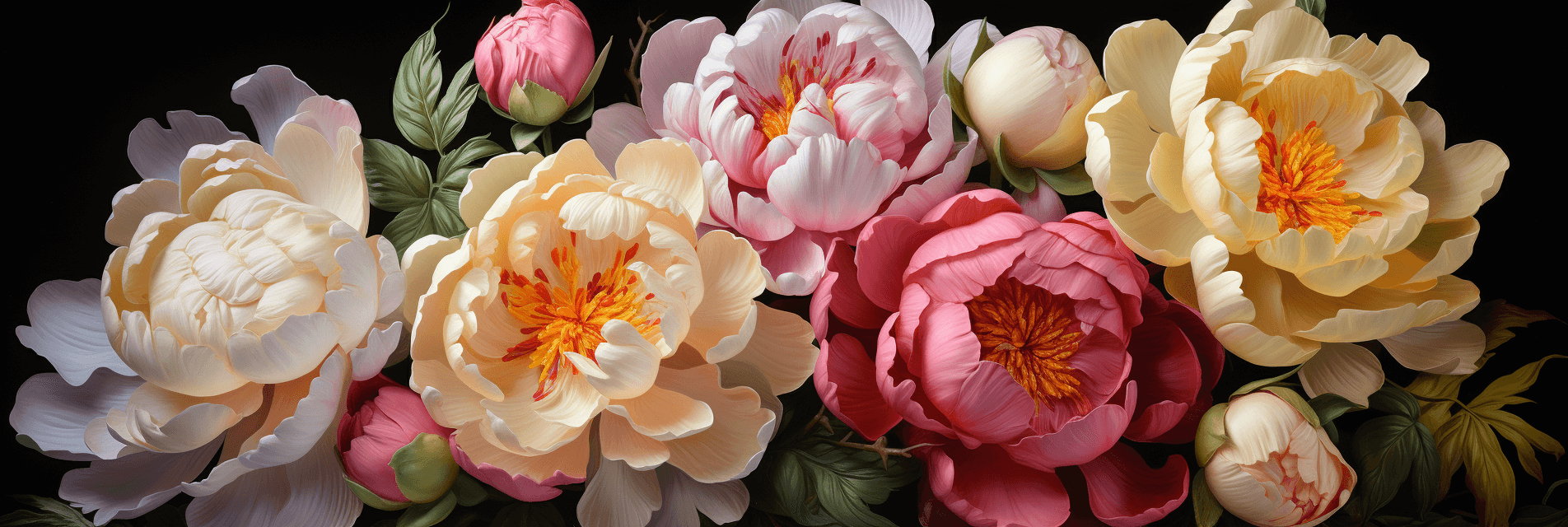
The Peony, with its voluminous petals and captivating fragrance, is a visual treat that comes in a spectrum of colors. Each hue carries its own unique symbolism, echoing tales of love, prosperity, and honor. Let’s embark on a colorful journey, exploring the myriad of emotions and messages conveyed by the different shades of the Peony.
| The Peony: A Spectrum of Emotions and Messages | |
|---|---|
| White Peonies | Purity, innocence, and elegance. Emblematic of new beginnings and enduring love, these pristine petals are a favorite for wedding ceremonies. |
| Red Peonies | Symbolizing passion, love, and respect, the deep red hue speaks of honor and is a token of deep admiration in many cultures. |
| Pink Peonies | With a hue signifying youth, joy, and grace, pink Peonies capture the essence of youthful adventures and early love’s sweet moments. |
| Yellow Peonies | Embodying the sun’s radiant energy, yellow Peonies symbolize wealth, prosperity, and good fortune. A perfect gift to wish someone success. |
| Coral Peonies | Blending passion and play, the coral hue represents desire, attraction, and the thrilling sensations of early love. A playful yet deep expression of affection. |
From the pure whites to the passionate reds, the Peony’s palette is a testament to its rich history and the depth of emotions it represents. Whether you’re choosing a Peony for a special occasion or simply to brighten someone’s day, understanding the significance of its colors can add a layer of meaning to your gesture.
Mythology and Folklore of the Peony: Stories of Beauty, Jealousy, and Divine Favor
The Peony, with its lush petals and intoxicating aroma, has been a subject of fascination and reverence in various cultures. Its beauty has inspired countless myths, legends, and tales that weave a rich tapestry of symbolism and meaning around this magnificent bloom.
The Greek Tale of Paeon
One of the most well-known myths originates from ancient Greece. Paeon was a student of Asclepius, the god of medicine. When Paeon managed to heal Pluto with a Peony root, Asclepius, consumed by jealousy, threatened to end his life. To save Paeon, Pluto transformed him into a Peony flower, which became a symbol of compassion and healing.
Chinese Legends of Wealth and Honor
In China, the Peony is often referred to as the “King of Flowers” and is associated with royalty and honor. Legends tell of the Peony being the favored flower of empresses and is often linked with wealth and prosperity. It’s believed that the Peony can bring good fortune and is especially revered during the Lunar New Year celebrations.
Japanese Tales of Beauty and Bravery
In Japanese folklore, the Peony is a symbol of beauty and bravery. Samurai warriors would adorn their armor with Peony motifs, believing the flower would bring them courage in battle. The Peony also features in tales of love and beauty, where its radiant petals are likened to the blush of a lover’s cheeks.
European Beliefs: Protection from Evil Spirits
In parts of Europe, the Peony was believed to offer protection. Its roots were often hung in homes and barns to ward off evil spirits and protect against misfortune. The flower was also thought to have magical properties, with the ability to safeguard one from storms and natural calamities.
Across continents and cultures, the Peony has been revered, celebrated, and cherished. Its tales of divine favor, beauty, and bravery resonate with many, making it a flower that’s not just admired for its aesthetics but also for the depth of its symbolic significance.
The Peony Across Different Cultures: Understanding the Global Adoration for November’s Treasured Bloom
The Peony, with its opulent petals and enchanting fragrance, has captured the hearts of many across the globe. Its presence in various cultures has led to a myriad of interpretations, uses, and celebrations, making it one of the most universally adored flowers.
China: The Flower of Riches and Honor
In China, the Peony is celebrated as the “flower of riches and honor.” Revered for its large, lush blooms, it’s often associated with prosperity and is believed to bring good fortune. The city of Luoyang, known as the Peony Capital, hosts an annual Peony Festival, attracting thousands of visitors who come to admire the vast gardens of blooming peonies.
Japan: A Symbol of Bravery and Honor
Japanese culture holds the Peony in high regard as a symbol of beauty, bravery, and honor. Historically, samurai warriors would wear Peony motifs, believing the flower would grant them courage. The Yatsuka town in Shimane Prefecture celebrates the Peony Festival every year, showcasing over 20,000 Peony plants of various colors and types.
Europe: The Protective Bloom
In European folklore, the Peony is often seen as a protective flower. Its roots were believed to ward off evil spirits and protect against misfortunes. In some parts, it’s also associated with romance and matrimonial bliss, often used in wedding bouquets and decorations.
United States: The State Flower of Indiana
In the United States, the Peony has a special place in the state of Indiana, where it’s designated as the state flower. Its vibrant blooms are a common sight in gardens and parks during the spring season, symbolizing the state’s appreciation for natural beauty and growth.
From lavish festivals in Asia to state symbols in the West, the Peony’s global appeal is undeniable. Its rich history, combined with its undeniable beauty, ensures that it remains a beloved flower in gardens, art, and hearts worldwide.
Frequently Asked Questions
Why is the Peony often associated with wealth and honor in Chinese culture?
In Chinese culture, the Peony is revered as the “king of flowers” and symbolizes wealth, honor, and high social status. Its lush, full blooms are indicative of prosperity, and it’s often used in art and decorations to attract wealth and good fortune. Historically, Peonies were exclusive to the imperial palaces, further cementing their association with nobility and honor.
How did the Peony become the state flower of Indiana?
The Peony was designated as the state flower of Indiana in 1957. Its popularity in the state, combined with its beauty and the fact that it thrives in Indiana’s climate, made it a fitting choice. The Peony blooms in late spring to early summer, around the same time as many of Indiana’s celebrations and events, making it a familiar and cherished sight for residents.
What are the medicinal uses of the Peony in traditional practices?
Traditionally, especially in Chinese medicine, various parts of the Peony plant have been used for medicinal purposes. The roots, in particular, are believed to have properties that can help with nerve-related issues, muscle cramps, and even menstrual pain. Additionally, Peony extracts have been used to treat inflammatory conditions and boost the immune system.
Why is the Peony considered a symbol of bravery in Japan?
In Japan, the Peony is admired not only for its beauty but also for its resilience. It’s often associated with bravery because of its bold and large blooms that stand out prominently. The Samurai of ancient Japan saw the Peony as a representation of their values, including bravery and honor. This association has persisted, and the Peony remains a symbol of courage and determination in Japanese culture.
How should I care for a Peony plant to ensure vibrant blooms?
Peonies thrive in well-draining soil and full sunlight. It’s essential to plant them at the right depth, with the eyes (buds) no more than 2 inches below the soil surface. Water them regularly, but avoid overwatering as they don’t like to sit in waterlogged soil. In the spring, you can apply a balanced fertilizer to give them a nutrient boost. Also, ensure they have ample space to grow, as crowded plants can lead to fewer blooms and increased susceptibility to diseases.
Can Peonies grow in tropical climates?
Peonies prefer temperate climates and require a period of winter chill to bloom properly. In tropical climates where there’s a lack of cold winter temperatures, Peonies might not bloom or may struggle to thrive. However, some tropical gardeners have had success with certain varieties by providing them with artificial chilling periods, but it’s a challenging endeavor.
What is the significance of the Chrysanthemum in Japanese culture?
In Japanese culture, the Chrysanthemum, or “Kiku,” holds profound significance. It’s a symbol of the Emperor and the Imperial family, representing longevity and rejuvenation. Every year, the “Chrysanthemum Festival” or “Kiku no Sekku” is celebrated, which is one of the five ancient sacred festivals of Japan. It’s a day to celebrate longevity and good health.
How long can a Chrysanthemum plant live?
With proper care, a Chrysanthemum plant can live for several years. However, many gardeners treat them as annuals because their blooming performance tends to decline after their first year. If you’re growing them as perennials, it’s essential to provide proper winter care, like mulching, to protect them from harsh temperatures.
Why are Marigolds commonly used in Day of the Dead celebrations?
Marigolds, especially the vibrant orange and yellow varieties, are often associated with the sun and its life-giving force. In the context of the Day of the Dead or “Día de los Muertos” celebrations in Mexico, Marigolds are believed to guide the spirits of the deceased back to the world of the living. Their bright colors and strong fragrance are said to attract souls and lead them to the altars families set up in their honor.
Is it true that Cosmos flowers are related to peace and love?
Yes, the Cosmos flower is often associated with peace, love, and harmony. Its name is derived from the Greek word for “order” or “harmony,” reflecting the balanced nature of the flower’s structure. In various cultures, gifting Cosmos flowers is seen as a gesture of deep love, peace, and appreciation. Their simple yet elegant beauty makes them a symbol of serenity and calmness.
Explore Other Birth Flowers
Journey through the distinct birth flowers of each month and uncover their symbolic significance:
| Month | Birth Flowers |
|---|---|
| January | Carnation & Snowdrop |
| February | Violet & Primrose |
| March | Daffodil & Jonquil |
| April | Daisy & Sweet Pea |
| May | Lily of the Valley & Hawthorn |
| June | Rose & Honeysuckle |
| July | Larkspur & Water Lily |
| August | Gladiolus & Poppy |
| September | Aster & Morning Glory |
| October | Marigold & Cosmos |
| November | Chrysanthemum & Peony |
| December | Narcissus & Holly |

